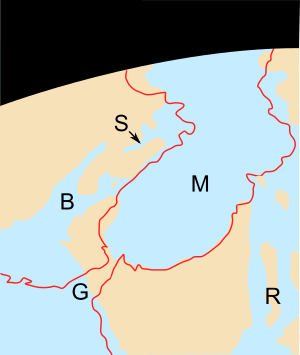Betic corridor facts for kids

The Betic Corridor, also called the North-Betic Strait, was an ancient waterway. It connected the Mediterranean Sea with the Atlantic Ocean. This strait separated what is now Spain (the Iberian plate) from the rest of Europe (the Eurasian plate). It ran through a mountain range called the Betic Cordillera.
About 5.96 million years ago, during a time called the Messinian period, this corridor closed. When it closed, it caused a huge event known as the Messinian Salinity Crisis. During this crisis, the Mediterranean Sea partly or even completely dried up!
Contents
What Was the Betic Corridor Like?
Scientists study the rocks and sediments left behind to understand the Betic Corridor. These rocks show that the corridor was a deep channel. It was filled with water that flowed between the Atlantic and the Mediterranean.
The rocks tell us about the water's movement. They show large patterns made by strong tides. These patterns suggest that the water was very deep, possibly up to 90 meters (about 300 feet) in some places. The corridor was deeper on the Atlantic side and became shallower as it reached the Mediterranean.
How Did the Corridor Change Over Time?
The Betic Corridor did not always look the same. It changed over millions of years.
- Early Stages: At first, it was a platform facing south. It was next to a high area in the northeast.
- Open Passage: Later, it became a wide-open sea passage. A southern platform bordered it.
- Tidal Strait: Finally, it turned into a narrow strait where strong tides moved the water.
How Did the Betic Corridor Close?
The closing of the Betic Corridor was a big event. Geologists found clues in the rocks that show how it happened.
In the western parts of the corridor, scientists found layers of muddy sediments. These sediments formed in a lagoon, which is a shallow body of water separated from the sea. On top of these muddy layers, there is a special type of rock called a stromatolite layer. Stromatolites are structures made by tiny living things, often found in shallow, salty water.
Above the stromatolite layer, there is a layer of red soil. This red soil tells us that the area eventually became dry land. These layers together show that the Betic Corridor slowly closed off from the ocean. This closure stopped the flow of water between the Atlantic and the Mediterranean, leading to the Messinian Salinity Crisis.
Why Was the Betic Corridor Important?
The closure of the Betic Corridor was a major geological event. It directly led to the Mediterranean Sea drying up. This event changed the climate and environment of the region dramatically. It also affected the types of plants and animals that could live there. Understanding the Betic Corridor helps scientists learn more about Earth's past and how continents and oceans change over time.
See also
 In Spanish: Corredor bético para niños
In Spanish: Corredor bético para niños

